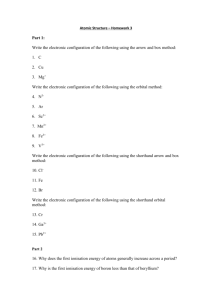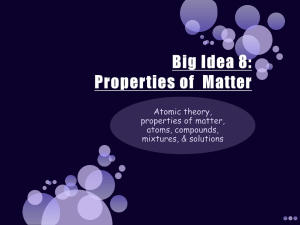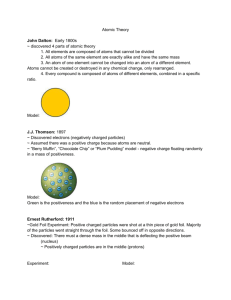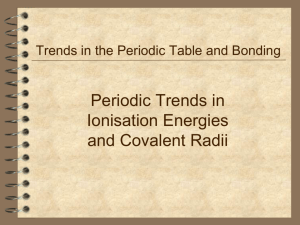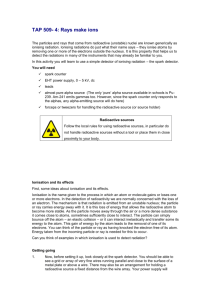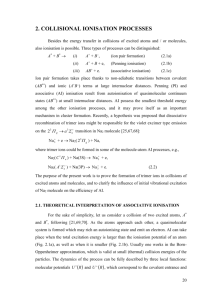Checkpoint task
advertisement
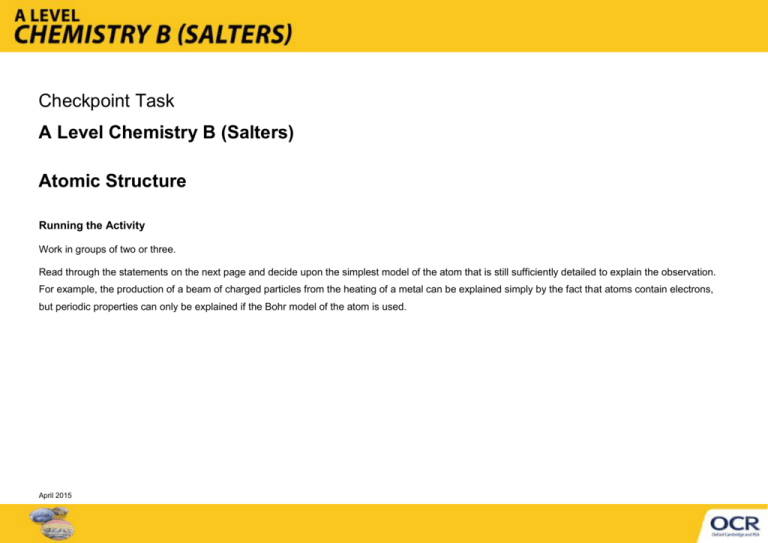
Checkpoint Task A Level Chemistry B (Salters) Atomic Structure Running the Activity Work in groups of two or three. Read through the statements on the next page and decide upon the simplest model of the atom that is still sufficiently detailed to explain the observation. For example, the production of a beam of charged particles from the heating of a metal can be explained simply by the fact that atoms contain electrons, but periodic properties can only be explained if the Bohr model of the atom is used. April 2015 When liquids are heated they turn Increasing the temperature increases into a gas – when this gas is cooled the rate of a chemical reaction. again, it turns back into a liquid. The first ionisation energy of sodium When light of a specific frequency is is much lower than the first shone on the surface of a metal, ionisation energy of neon. charged particles are given off (this is known as the photoelectric effect). Particles of dust or smoke appear to Many chemicals can be split up into move randomly through water or air, separate substances, but there is a changing direction all the time limit to this – eventually you will get (Brownian motion). a ‘pure’ substance. When positively charged alpha particles are fired at a thin piece of The second ionisation energy of gold foil, most of them pass straight magnesium is much lower than the through but some are deflected second ionisation energy of sodium. straight back. The first ionisation energy of oxygen Atoms of the same element, with the The properties of elements show is slightly lower than the first same chemical properties, can have periodicity when the elements are ionisation energy of nitrogen. different masses. placed in order of increasing atomic number. The total mass of substances at the Two chemical reactions in separate end of a chemical reaction is the containers can produce a potential same as the total mass at the difference (voltage) if connected by a beginning. wire. April 2015 Metal electrodes can give off tiny particles that are attracted to a positive plate. The first ionisation energy of The absorption and emission spectra aluminium is slightly lower than the of hydrogen consist of discrete lines. first ionisation energy of magnesium. Democritus Everything is made up of tiny particles called atoms. The atom is indivisible. April 2015 John Dalton J.J. Thomson Ernest Rutherford Atoms contain tiny negatively charged The positive charge and mass of the Atoms cannot be created or destroyed. particles called electrons. The rest of atom is concentrated in a tiny nucleus in Elements are made up of only one type the atom is positive to balance out the the centre of the atom. The electrons of atom. Atoms join together in chemical charge, and the electrons are exist randomly in the space around the reactions. embedded in this like pieces of fruit in a nucleus. pudding. April 2015 Niels Bohr James Chadwick Louis de Broglie Electrons are not randomly arranged around the atom. They exist in specific shells – like the orbits of the planets. Some of the mass of the atom is accounted for by an uncharged particle, called a neutron. The neutron does not affect chemical properties of an element. Just as waves can sometimes behave like particles, very small particles – like electrons – can behave like waves.





